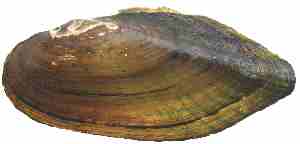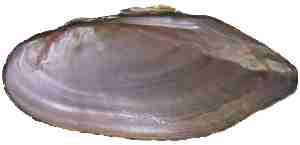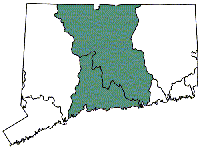Eastern Pondmussel
Ligumia nasuta
Species of Special Concern
Key Features
Size: Up to six inches.
Shape: Narrow and elongate, tapering to a blunt point posteriorly. Females are often distinctly more rounded along the posterior ventral margin. Valves laterally compressed, thin, and strong.
Periostracum: Color yellowish or greenish-black (juveniles) to dark brown or black (adults). Shell rays are often only visible in juveniles or light-colored adults.
Lateral Teeth: Present but delicate. Two on the left valve and one on the right valve.
Pseudocardinal Teeth: Present but delicate. One or two on both the left valve and right valve.
Nacre: Color usually silvery-white, pinkish, or purple.
Often Confused With ... Not easily confused with any other species in Connecticut, although the eastern pearlshell may have a similar elongate shape.

External shell

Internal shell, right valve

Hinge teeth
 Habitat: The eastern pondmussel inhabits a variety of habitats such as coastal ponds, streams, and rivers.
Habitat: The eastern pondmussel inhabits a variety of habitats such as coastal ponds, streams, and rivers.
Range in Connecticut: Known from the Connecticut River watershed and south-central coastal watersheds.
Conservation: The eastern pondmussel is listed as special concern in Connecticut. Many of its historic populations are thought to be extirpated or in decline, and there are few remaining populations that are considered healthy and stable. Environmental pollution and habitat degradation are considered the primary reasons for its decline. It is also listed as special concern in Massachusetts.
Freshwater Mussel Fact Sheets
Eastern Pearlshell
Dwarf Wedgemussel
Triangle Floater
Brook Floater
Creeper
Eastern Elliptio
Eastern Floater
Alewife Floater
Eastern Pondmussel
Tidewater Mucket
Yellow Lampmussel
Eastern Lampmussel
The Freshwater Mussels of Connecticut
Content last updated on January 29, 2014.

